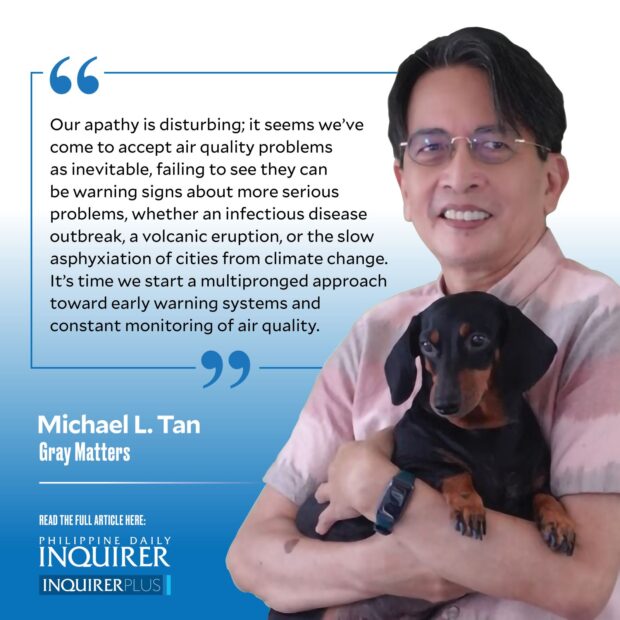From canaries to citizens

Those were apocalyptic days what with dark skies, dirty drizzling, and a mad jumble of malaise and symptoms affecting the eyes, nose, throat. Less than two weeks later, everyone seems to have forgotten what happened.
Let’s not forget, too, that a few days after the vog and smog in Luzon, four Cagayan de Oro schools, including Xavier University, went back to online classes after an outbreak of flu-like symptoms among students. In a college I run in Tagaytay, we had 21 students with flu-like symptoms … a week before the vog. We had them tested for COVID; all were negative.
Article continues after this advertisementNo one seems to know, for sure, what actually happened except that Taal volcano acted up. Metro Manila’s smog was never explained in terms of air quality measurements. As far as I know, there was no monitoring and research on hospital admissions: was there really a rise or not, and what were the diagnoses?
Our apathy is disturbing; it seems we’ve come to accept air quality problems as inevitable, failing to see they can be warning signs about more serious problems, whether an infectious disease outbreak, a volcanic eruption, or the slow asphyxiation of cities from climate change.
It’s time we start a multipronged approach toward early warning systems and constant monitoring of air quality. There’s an app called IQAir managed by the manufacturer of air quality monitoring machines. The app has a map you can use to identify places, throughout the world, where there are such machines installed, with readings of an Air Quality Index and PM2.5 or measurements of fine inhalable particles with diameters that are 2.5 micrometers and smaller. Right now I’m looking at readings from a gasoline station on Shaw Boulevard, near where I live, and the measurements there are rated as good (wow, a gas station with good air?).
Article continues after this advertisementLast year the UP Diliman Institute of Chemistry’s director, Dr. Len Lim, helped me with a class in biological anthropology where students had a wearable monitor for air quality. Students got to bring home the gadgets and see, for themselves, what areas in their environments had good or problematic air quality and to look for explanations for the quality. It was part of a project with Wageningen University called Embodied Ecologies, looking into how people use their senses to evaluate their environment. The air quality wearable technology was more specific but was meant to demonstrate how problems are not always caught by our senses.
Besides machines with sensors, we should also be thinking about what I call multispecies sensory monitoring. I was reminded about how different animals have different sensory capabilities when I stayed overnight in Tagaytay during the vog and noticed my dachshund Chi (who’s staring at you right now) was having difficulty breathing. Chi snores in her sleep but this time she was wide awake and I realized she was actually wheezing … and that I was wheezing, too. I have asthma but I never thought of Chi having asthma as well!
You may have heard about canaries in mines. In the 20th century in the US and England, coal mines had canaries brought underground in cages to the mine. The canaries became, in a sense, pets for the miners but served another purpose. The birds are very sensitive to carbon monoxide and toxic gases, which are colorless and odorless and therefore undetectable by humans. In contrast, the more gas-sensitive canaries would fall ill or drop dead when exposed to the gases, a warning to the miners to evacuate the mines (which they did, together with the canaries that hadn’t died). The canaries were phased out after digital sensors took over … but miners were known to complain about missing the birds.
We could set up a system to educate people about the different signs of deteriorating air quality, and possible causes, and have people calling or texting a communications center about the signs we’re detecting. We could make it multispecies, including reports if our animals are getting anxious and uneasy. The data could then be compiled and interpreted by expert scientists, who would issue advisories to the public on what to do.
It’s called citizens’ science. I caught a documentary on Netflix some time back featuring a citizens’ science network in the United States for reporting flood hazards and occurrences. Its coordinator explained that satellite technology is great but they don’t always detect what’s actually happening right on the ground.
Chi and I are ready to volunteer!
—————-
mtan@inquirer.com.ph
















